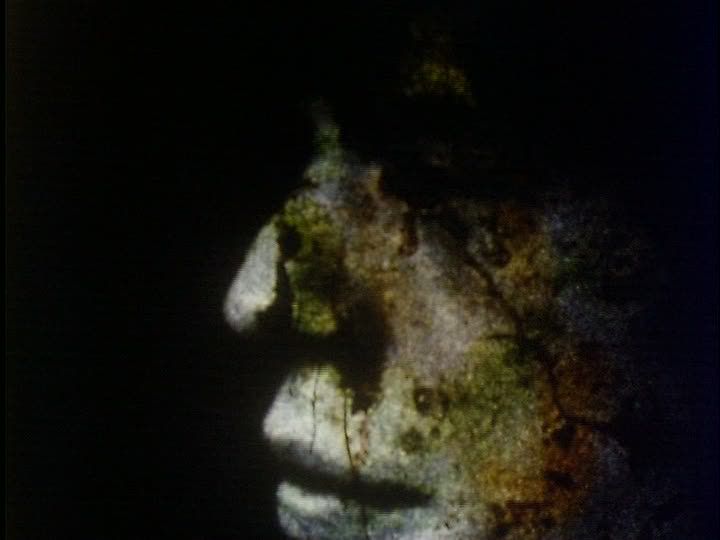
Filmska meditacija o životu, smrti, židovskom misticizmu, politici i pop-kulturi. Hipnotična, luda vožnja koja kolaž tretira kao radio-tranzistor. "Jedini istinski prikaz duha šezdesetih" (Stan Brakhage)


Aleph, the only film made by Beat artist Wallace Berman, is a frantic collage that represents, in a brisk 9 minutes, a kind of hyper-speed gestalt vision of the 1960s and all that that wild, tumultuous decade represented. Berman, a poet and artist, worked on Aleph as a kind of private journal, continuously altering it and adding to it, collaging together the images that fascinated him and subjecting them to a process of degradation, layering and frantic editing so that each image is merely a momentary flash before the eyes, flickering into motion and then vanishing within the deluge of visual stimuli that Berman stitches together for this film. He apparently uses newsreels, still photos, home movies, advertising cutouts, and any other visual material he can get his hands on, building upon these varied foundations a powerful document of 60s culture.
The haunting beauty of this film arises from the impression that it is constantly on the verge of falling apart, or that perhaps Berman assembled it from exhumed materials encrusted with the wear of the ages. The film crackles and pulses with the signs of film degradation: burns, brown-hued scars and scratches, black lines shimmering across the frame. To this, Berman adds his own defacements, layering on additional colors and superimposing text — flashing across the frame too fast to read, mostly composed of Hebrew writing and other glyphs anyways — on top of the rapidly moving stream of images. These images originated from a variety of sources, ranging from private, intimate footage to the public appearances of celebrities, radicals and world figures. Bob Dylan, Mick Jagger, the Pope, pulp magazines, softcore porn, home movies, Alice in Wonderland, a snatched shot of a movie theater marquee playing It's a Mad, Mad, Mad, Mad World. The 60s vibrate and pulse through Berman's film, in every frame: all the chic 60s girls, lounging around in long dresses or in the nude, practicing free love; the radicals reading books with delicate wire glasses looking out-of-place on their hard faces; Dylan looking young and baby-faced the way he did on the cover of his eponymous first album; Jagger, as always, stretching those rubbery lips to sing or shout; sober, suited politicians in clusters, caught from above so their bald spots show. All of this is contained by Berman's film, appearing and then disappearing, returning in subtle rhythms.
The film has something of the aesthetic of an old photograph, decaying and rotting with age. Figures and faces seem to emerge from an encrustation of rust, and the images are frequently textured, thickly layered with paint and markings and scratches across the emulsion of the film. The sheer variety of the images, and the pace of the editing, gives the film a surging forward momentum, a vibrancy that captures the sense of freedom and enthusiasm running through this era. And yet at the same time the whole thing seems already retrospective, an artifact of the past, assembled throughout the peak of the 60s and yet already with a built-in nostalgia in its half-obscured images, a sense of looking back at a moment already lost. There is, in this film, a nostalgia for a time that had not even yet ended when this film was made, as though Berman already sensed the import of this era and the ways in which it would someday be eulogized and remembered. It is thus by turns a haunting film, a joyous one, an aggressive one, cycling through moods and impressions as quickly as its images flicker by.
This impression is enhanced by the film's lack of a proper soundtrack. It is totally silent, though when showing it privately, which was pretty much the only way Berman ever did show it, he often accompanied it with a random record. The film is more or less a very radical home movie, intended for home viewing, constantly subject to change, always being reworked or paired with whatever music was at hand. It is a film very much alive with the circumstances of its own construction, and with the spirit of the era captured so memorably in its torrent of images. - Only the Cinema
Wallace Berman (February 18, 1926 – February 18, 1976)
Like a number of Beat artists, Wallace Berman experimented in film. A native of Staten Island, Berman moved with his family to Los Angeles in the 1930s. There he became a key figure in West Coast counterculture and created Semina (1955-64), a hand-printed mail-art proto-zine disseminating poetry and art by Berman, William Burroughs, Charles Bukowski, Allen Ginsberg, and Lawrence Jordan, among others. The artist died on the eve of his 50th birthday, after being hit by a drunk driver.
Aleph (1958-1976) 6 minutes, 16mm, color, silent
"This film took a decade to make and is the only true envisionment of the sixties I know." - Stan Brakhage
Aleph, Berman's only film, was begun soon after the release of the first issues of Semina and was created with techniques carried over from collage and painting. The work was originally shot on 8mm black-and-white stock. Berman edited and shaped his unique copy by adding hand coloring, Letraset symbols, and collage portraits of pop-culture icons, which he sometimes superimposed on images of a transistor radio. According to his son, Tosh, the artist regarded the print as a "creative notebook" and made additions over the years. After Berman's death, filmmaker Stan Brakhage salvaged the film and enlarged it to 16mm for public screening.
Heralded by Brakhage as "the only true envisionment of the sixties I know," Aleph captures the era's contradictions - its optimism, sense of alienation, and intensity. The film pulses with energy. Tosh likens Aleph to his father's studio - an overwhelming, seemingly random assemblage of objects placed with exacting care. In Aleph, stills come to life and appear to dance to a staccato beat.
Berman did not give his film a title. Tosh named it Aleph, after the first letter of the Hebrew alphabet, which was adopted by his father as a monogram. Berman's evocative use of the Hebrew characters reflected a fascination with Kabbalah, a system of Jewish mysticism. Kabbalah translates as "receiving," and through Kabbalah's mysterious workings, Berman believed, language and image receive ecstatic unification as art.
Berman rarely permitted public screenings and preferred to show his film privately, often to a single friend. Tosh remembers his father projecting Aleph without music but occasionally accompanying it with a favorite record, anything from James Brown's "Papa's Got a Brand New Bag" to a work by Edgar Varèse. Here Aleph is presented with new music created by John Zorn, composer-in-residence at Anthology Film Archives.
—From the linner notes of the DVD Treasures IV: American Avant-Garde Film, 1947-1986
Wallace Berman was born in Staten Island, New York in 1926. While he was still a child, he correctly predicted that he would die on his 50th birthday. He was hit by a car in 1976.
During those five decades, Berman became a pioneering assemblage artist as well as one of the cornerstones of the post WWII California art scene. Berman became associated with the Beats and his self-published magazine Semina combined his own collage imagery with writing by luminaries like Michael McClure, Philip Lamantia, David Meltzer, Charles Bukowski, William S. Burroughs, Allen Ginsberg, Jean Cocteau. In addition to his groundbreaking, multimedia assemblages, Berman made the short film Aleph. The artist’s only experiment with moving pictures,Aleph reveals both Berman’s love of collage as well as his interest in the Kabbalah.
Here is what www.jewishmuseum.org has to say about the film: - www.disinfo.com/
Aleph is an artist's meditation on life, death, mysticism, politics, and pop culture. In an eight-minute loop of film, Wallace Berman uses Hebrew letters to frame a hypnotic, rapid-fire montage that captures the go-go energy of the 1960s. Aleph includes stills of collages created using a Verifax machine, Eastman Kodak's precursor to the photocopier. These collages depict a hand-held radio that seems to broadcast or receive popular and esoteric icons. Signs, symbols, and diverse mass-media images (e.g., Flash Gordon, John F. Kennedy, Mick Jagger) flow like a deck of tarot cards, infinitely shuffled in order that the viewer may construct his or her own set of personal interpretations. The transistor radio, the most ubiquitous portable form of mass communication in the 1960s, exemplifies the democratic potential of electronic culture and serves as a metaphor for Jewish mysticism. The Hebrew term kabbalah translates as "reception" for knowledge, enlightenment, and divinity.
According to the artist's son Tosh Berman, Wallace Berman treated Aleph "...as a creative notebook, and like a true diary, it has no beginning and no end." The hand-painted 8mm film was shot over a ten-year period with some images photographed on 16mm. After Berman's death, the late experimental filmmaker Stan Brakhage preserved the damaged print and transferred the reel to 16mm. The Jewish Museum recently acquired this version of the film as a limited edition DVD.
Wallace Berman (1926-1976) is gaining wider recognition today for a visionary body of work that encompassed assemblage, photography, collage, drawing, sculpture, poetry, and mail art. [His Verifax collage Silent, 1967-69 is currently on view in the second floor exhibition Collective Perspectives: New Acquisitions Celebrate the Centennial.] Berman's engagement with kabbalah reflected the Beat Generation's wider exploration of esoteric spiritual practices such as Zen, palm reading, astrology...and psychedelic drugs. Born on Staten Island, Berman moved with his family to Los Angeles during the 1930's. In the Jewish neighborhood of Boyle Heights and the Fairfax district, the decorative shapes of Hebrew letters on storefront windows and in Yiddish-language newspapers fascinated Berman. According to historian Richard Candida Smith, "Berman's interest in the Hebrew alphabet and its functions in Jewish mysticism was part of an effort to reclaim his ethnic identity." - www.thejewishmuseum.org/













Nema komentara:
Objavi komentar